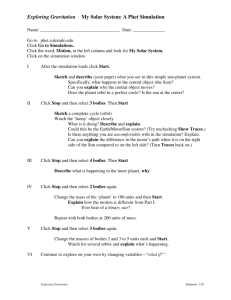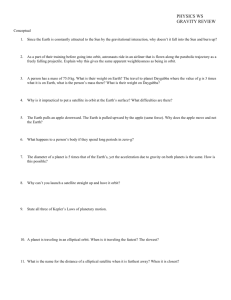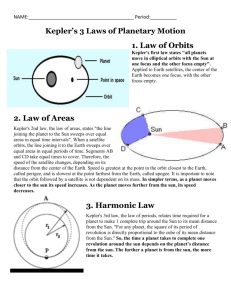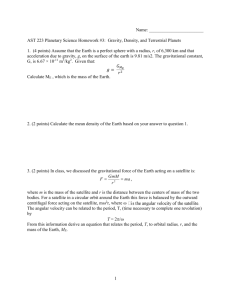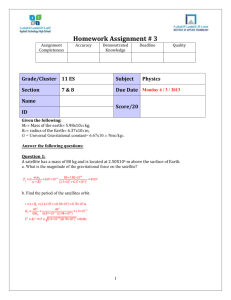class32_S2012_final
advertisement
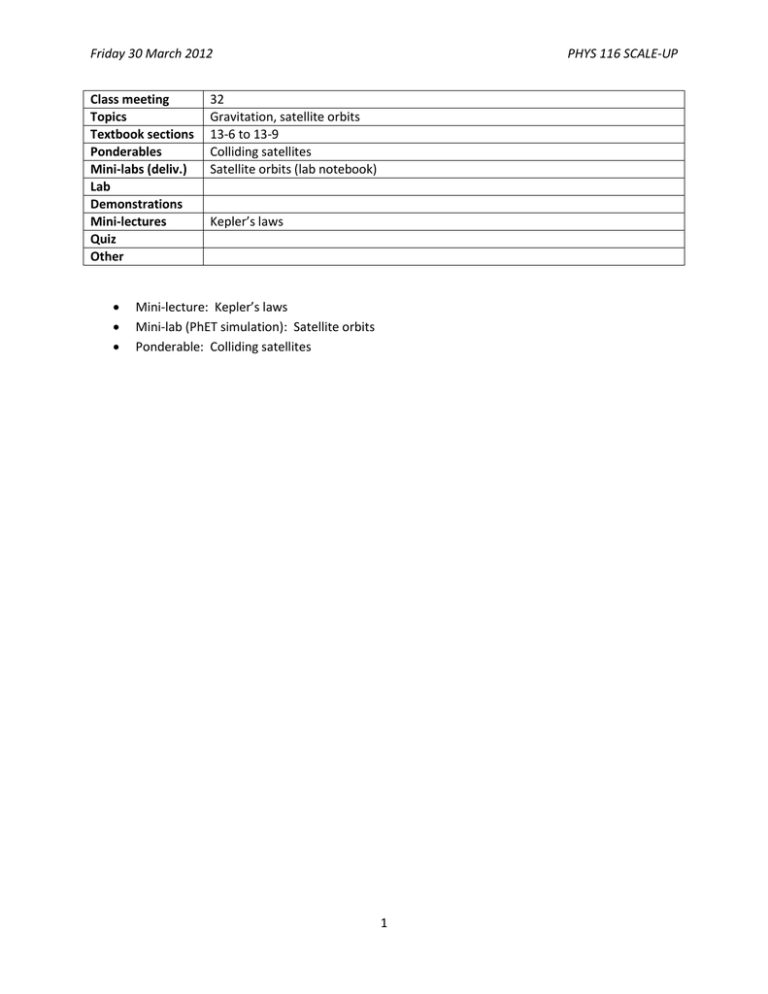
Friday 30 March 2012 Class meeting Topics Textbook sections Ponderables Mini-labs (deliv.) Lab Demonstrations Mini-lectures Quiz Other PHYS 116 SCALE-UP 32 Gravitation, satellite orbits 13-6 to 13-9 Colliding satellites Satellite orbits (lab notebook) Kepler’s laws Mini-lecture: Kepler’s laws Mini-lab (PhET simulation): Satellite orbits Ponderable: Colliding satellites 1 Friday 30 March 2012 PHYS 116 SCALE-UP SATELLITE ORBITS Explorations In this mini-lab you will explore how the orbit of a satellite or planet depends on parameters such as its distance from the star, its mass, and its velocity. You will use the simulation program “My Solar System” found at http://phet.colorado.edu/sims/my-solar-system/my-solar-system_en.html Note that in this simulation there are no units attached to the numerical values, so all derived numbers are relative. You will record your observations in your lab notebook. Task 1: Under “Select Preset,” choose “Sun and planet.” Set the mass of body 1 (the star) at some large value and choose a much smaller mass for the planet. The default values of 200 and 10 are acceptable but if you adjust the value for the planet further, do not increase it. Set the “fast/accurate” slider to be close to “accurate.” a. Launch the planet in orbits with 4 or 5 different values of initial location and velocity to verify 4 2 GM Kepler’s 3rd law T 2 3 a , recalling that M is the mass of the Sun, T is its orbital period, and a is the semi-major axis of the elliptical orbit. Use the tape measure in the program to find a, and the start/stop buttons to accurately measure the orbital period. (Is the planet orbiting about the Sun, or about some other point?) Which variables can be plotted against one another to determine the constant 4 2 ? Make such a plot, but do not try to calculate the constant (the GM numbers in the simulation are not in sensible units). Instead, focus on finding a way to make the plot linear – how would you do this? [Hint: try taking the logarithm of both sides of the equation.] b. Verify that angular momentum is conserved in the orbit. You can determine the position and velocity of the planet by hitting “stop” to temporarily pause the simulation, passing your mouse over the satellite to read the values, and then hitting start to resume the simulation. [Hint: there is an easy way and a hard way to calculate this – what locations in the orbit make the calculation easy? Recall how the angular momentum of a moving particle is defined.] 2 Friday 30 March 2012 PHYS 116 SCALE-UP Applications (For numbers 1, 2, and 3, record the simulation settings in your lab notebook so the grader can check your observations) 1. Use the same simulation program, but under “Select Preset,” choose “Sun, planet, moon.” Start the simulation and observe the motion, which describes a very common circumstance you’ve observed many times in your life, although you may have never viewed it in this fashion. Pause the simulation at the locations of the “new” and “full” moons to develop an explanation of why the moon’s phases exist. 2. Reset the simulation and change the moon’s initial potential energy by small amounts (5% at a time – by what percentage does the position need to change to get such a change in potential energy?) while keeping the same masses and initial kinetic energies. Describe the resulting behaviors of the moon’s orbit. 3. Reset the simulation and change the moon’s initial kinetic energy by large amounts (50% or 100% at a time – by what percentage does the speed need to change to get such a change in kinetic energy?) while keeping the same masses and initial potential energies. Describe the resulting behaviors of the moon’s orbit. Why is it that relatively small changes in potential energy but relatively large changes in kinetic energy are required to significantly change the character of an orbit? 4. A satellite is in an elliptical orbit with a period of 8.00 x 104 s about a planet of mass 7.00 x 1024 kg. At aphelion (its furthest distance from the planet) it is 4.5 x 107 m from the center of the planet and traveling at an angular speed of 7.158 x 10-5 rad/s. What is its angular speed at perihelion (its closest approach to the planet)? 3 Friday 30 March 2012 PHYS 116 SCALE-UP COLLIDING SATELLITES As a result of your excellent performance in PHYS 116, you have gotten a summer job with NASA monitoring satellite orbits. One day during a routine survey you find that a 400 kg satellite in a 1000 km high circular orbit is going to collide with a smaller 100 kg satellite traveling in the same orbit but in the opposite direction. Knowing the construction of the two satellites, you expect they will become enmeshed into a single piece of space debris. When you notify your boss of this impending collision, he asks you to quickly determine whether the space debris will continue to orbit or will crash into the Earth. What will be the outcome? 4
